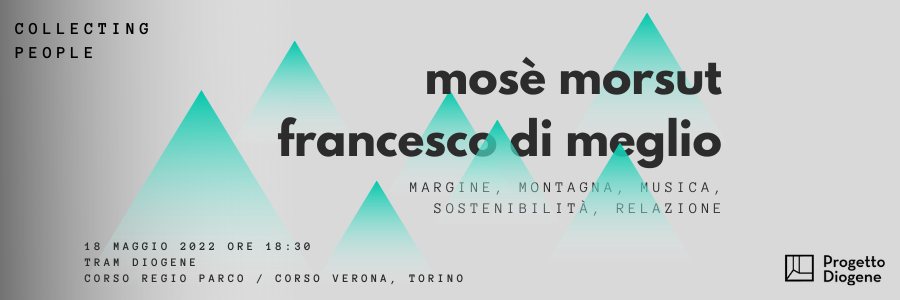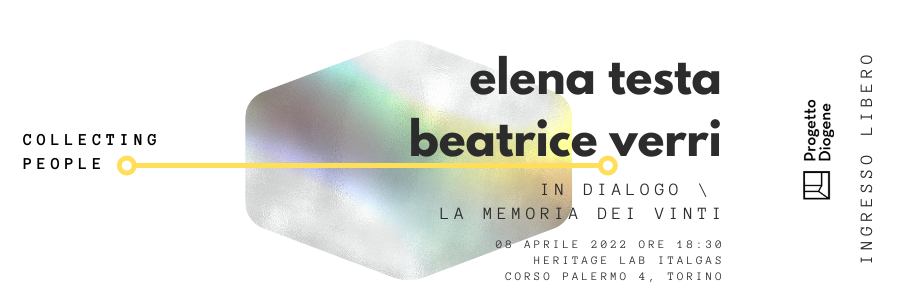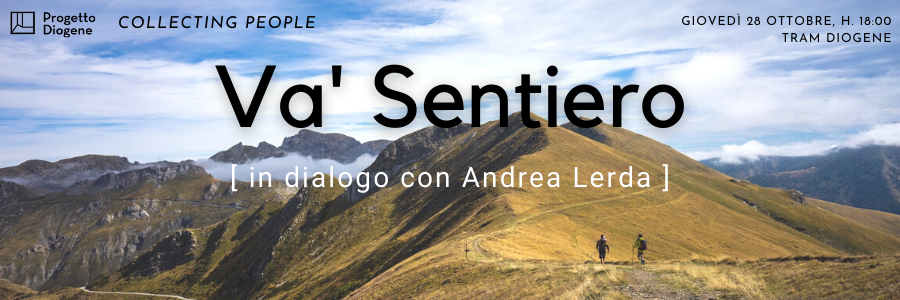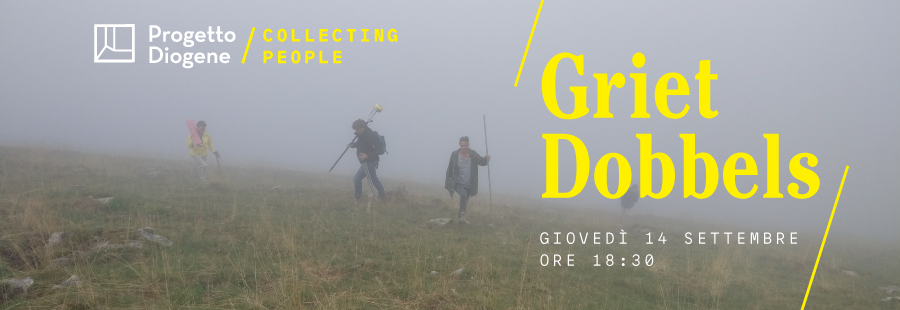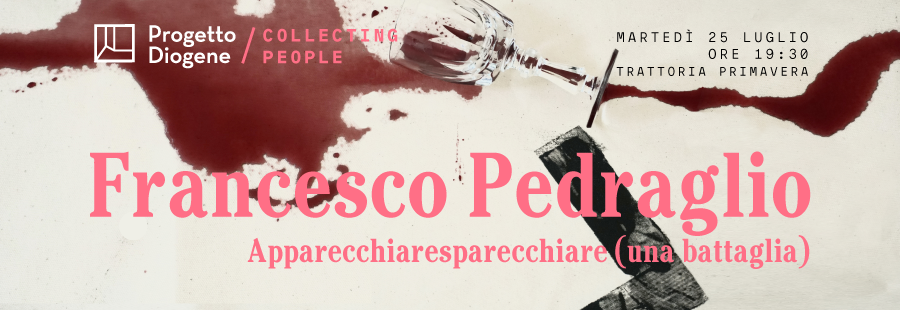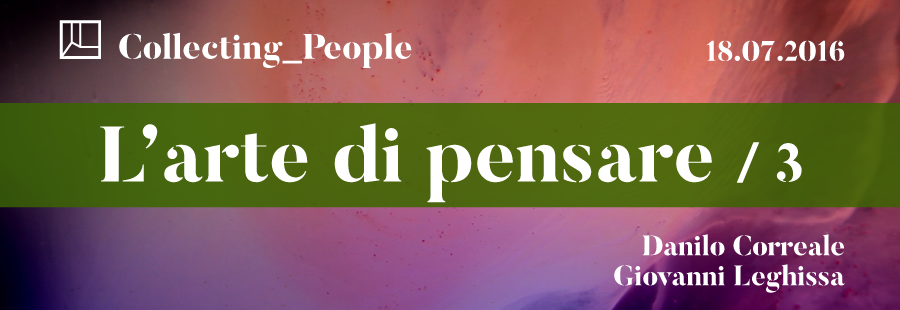Collecting People is an initiative aimed at sharing and disseminating knowledge, through which Progetto Diogene opens up meetings and interventions, sometimes determined by the simple passage in the city of an artist, or any other figure with a high cultural profile, inclined sharing their work.
COLLECTING PEOPLE | Mosè Morsut and Francesco Di Meglio. Margin, Mountains, Music, Sustainability, Relationship
>>>Wednesday, May 18th, 6.30 pm
Tram Diogene, Rotonda C.so Regio Parco e C.so Verona, Torino
At the end of September 2019, the young guitarist Moses Morsut completed his project Pizzicando le Alpi, a journey on foot through the Alps on the Sentiero Italia: 1087 kilometers, 49021 500 meters of altitude difference uphill and 51834 downhill, for 91 days of walking, offering concerts in exchange for food and accommodation. On 19 May 2022 he will leave again to take this time “L’altra Via” that connects Turin to Savona.
The project of Mosè Morsut aims to make experience of the mountain following the slow rhythms that characterize it and that better respect it, supporting an approach to the mountain respectful of its spaces, its inhabitants, of its severity and balance. The character of the path is based on mutual exchange (the mountain huts have offered food and accommodation in exchange for concerts and four sponsors have supported the project by providing materials and skills), on an empathic and creative interaction not only with people, but also with the territory of “margin” understood as a resource, as a space of possibility. Mosè promotes his music in a different and free acoustic dimension like that of valleys and mountain huts, taking into account that marginality is not a residual part, but is indeed a decisive feature to overcome the challenges of contemporaneity, to find a new way of sharing resources that considers important slowness, waiting, fatigue, unpredictability, fragility, the power of relationships, solidarity, the little things that are also the value of the polis, of the community.
NEMO Nuova Economia in Montagna, association and cooperative of which Francesco Di Meglio is president, is a widespread project of territorial animation of the Inland Areas with the aim of generating an economy based on collaborative processes aimed at creating communities; is an open system of relations between people and organizations, an interpreter of the potential of mountain territories.
The Tram Diogene was born inspired by mountain bivouacs that adapt to the morphology of the places, using the pre-existing forms of natural shelters; the example of Diogenes of Sinope and his barrel can be considered contemporary in our opinion: the abandonment of the superfluous, through a practice of experimentation, resistance and sustainability, leaves room for the exercise of listening, the practice of doing and participatory reflection. In the same way, the connections between the mountain and the city can encourage the encounter between subjects belonging to different contexts, environments and communities, so as to create moments of sharing, integration and recognition, to build a comparison on “the sense, the discomfort, the beauty, of living in the place from which one observes the world” (Vito Teti, La restanza, 2022).
Mosè Morsut began playing the guitar at the age of 8. After many years of classical studies with important teachers like Maurizio Colonna, he then experimented with modern music, and participated in several festivals and music fairs (cremona mondo musica, ADGPA Guitar rendez vous, Sarzana guitar meeting, Parma reggio Guitar fest). On 21 March, 2019, he publishes “PUZZLE” the first disc containing his music: a record without lyrics, without words, only with notes, sensations and flavors. The packaging of his disc is plastic-free, a paper origami illustrated by Eugenio Cesaro (voice of Eugenio in Via Di Gioia). On June 23, 2019, Moses set out “Puzzle” taking it to high altitude in a series of concerts traveling along the shelters of the Sentiero Italia. He then leaves for 91 days of travel completely on foot, 1087 km during which he plays in 51 different places! His tour, named “Pizzicando le Alpi”, ends on 22 September 2019 in the main square of Tolmezzo (UD). From 19 to 28 May 2022 the guitarist Mosè Morsut is the protagonist of the project “Pizzicando l’altra via”, a tour of concerts along the 9 stages of the way “L’altra Via” that connects Turin to Savona: 206 km., 9 concerts, crossing the Monferrato, the Roero, the Langhe, the Ligurian mountains to get to the sea.
Francesco Di Meglio is a founding member and president of the cooperative NEMO Nuova Economia in Montagna, an open system of relationships between people and organizations, interpreter of the potential of mountain or marginalized territories, and facilitator in the construction of networks towards a common goal: to generate an economy oriented towards the pursuit of social and environmental objectives, based on collaborative processes aimed at creating communities. Nemo is an association since 2019, and a cooperative in 2020. NEMO is a network of professionals from different backgrounds, a rich and interdisciplinary team that shares a passion for the development of the territory, and for the well-being of people and communities.
Di Meglio is a professional and environmental educator with experience in the fields of disability, psychiatry, children in difficult situations, prisoners and the elderly. Over time he has been a naturalistic accompanist and environmental trainer, sheep and goat shepherd, operator and cultural organizer, socio-environmental evaluator of companies. For a long time he interspersed, for necessity and pleasure, life in the city and in the mountains. Thanks to NEMO tries to make synthesis and decide, together with others, where and how to live well.
COLLECTING PEOPLE | Elena Testa and Beatrice Verri. La memoria dei vinti
>>>Friday, April 8th, 6.30 PM
Heritage Lab Italgas, Corso Palermo 4, Turin
The need to archive and preserve accompanies any human, private and collective activity.
Often the future use of information and documents is not foreseeable; it is therefore necessary to form the awareness that even the disorder of the data, the partial or total loss of information, the deliberate destruction are possible acts with circumstances to be managed. With Beatrice Verri and Elena Testa we will try to discuss the issue of the archive space as a place of thought and perspective of historical project, as a critical system that looks to the future: data, information, documents are not just quantities, but first of all they are devices that tell stories, and to know how to read them you need to know, compare and interpret by making choices.
Through the spontaneous dialogue between personalities and different but similar researches, we will try to find meeting points that can in some way act as humus for contemporary artistic research.
We’ll be host by Heritage Lab Italgas.
>>> The Italgas museum-laboratory, Heritage Lab, has the mission of digitizing the company’s historical heritage and enhancing the possible narratives of its notified archive, in constant dialogue with local partners, national and international, and as part of the vast network of the Time Machine Consortium. Heritage Lab uses innovative machines from Factum Arte and ARCHiVe, technologically evolved from the prototypes of the Cini Foundation, capable of reproducing large quantities of documents in very high resolution. In partnership with other cultural players, such as the Contemporary Jewish Documentation Center Foundation, Heritage Lab aims to become a research center in historical reconstruction and an international center of digital humanities dedicated to the massive digitization of business archives, with which it has started a dense exchange and cooperation activities. Alongside cultural production, the social element is alive in Heritage Lab that aims to reactivate interrupted work paths, training new professional figures: humanists and digital humanists.
Elena Testa is in charge of the National Cinema Impresa Archive of Ivrea, department of the Experimental Center of Cinematography Foundation. You are involved in the conservation, archiving, reuse and enhancement of repertoire film material. She is an expert in corporate cinema and the relationship between cinema and the world of work, she has written documentaries, directed short films and curated reviews for festivals and cultural institutions.
Beatrice Verri, translator and editorial curator, is also Director of the Nuto Revelli Foundation for which she coordinated the process of alpine regeneration based on culture of the historic village of Paraloup in Valle Stura, of which she is in particular responsible for the “Ring Strong” Laboratory for memory of mountain women. On the theme of female historical memory, you have carried out research, written contributions and edited the dedicated section of the Paraloup Tales Museum. You are President of the Chierese Community Foundation and a member of the Governing Council of the National Association of Memory Landscapes representing Borgata Paraloup.
COLLECTING PEOPLE | Va’ Sentiero in dialogue with Andrea Lerda
>>>Thursday, October 18, 6 pm
Tram Diogene, Rotonda C.so Regio Parco e C.so Verona, Torino
As part of Collecting People, an initiative aimed at sharing knowledge through encounters and impromptu interventions, Progetto Diogene presents Va ‘Sentiero, a travel project along the Sentiero Italia, a little-known path of about 7,000 km that unites all the Italian mountains by riding uninterruptedly the back of the Alps and the Apennines, from Friuli-Venezia Giulia to Sardinia.
Va ’Sentiero is an idea of travel based on the concepts of discovery, sharing and circularity; it is a three-year adventure, to rediscover the centrality of the mountain and tell its people. Va ‘Sentiero is the catalyst for a collective evolution: that of travelers and the cultural, social and territorial one of the highlands.
The seven young protagonists of Va ‘Sentiero see, in the thousands of kilometers of this itinerary, not only hardships and distances, but a way to create relationships, to experience places more intensely, to participate in the margins of reality, to find balance.
Diogenes of Sinope walked a lot. His phrase solvitur ambulando (walking is resolved) is perhaps the step that led Progetto Diogene to focus on the interaction between theory and practice, between thinking and doing, through an ideal relationship with reality linked to a reduction of the superfluous to the strictly necessary. and a careful observation of the surrounding world.
The relationship between the self and the context, the continuous interaction between chance and intention, the experimentation of when and where one is – issues that place us on the vertical axis of life and that characterize the progress of those who choose to set out – are distinctive aspects of artistic research that moves in departures, false paths, efforts, leaps, goals, peaks, transgressions, sharing, contingencies and falls.
Through the comparison with Andrea Lerda, curator of the National Museum of Montagna di Torino, we will try to share experiences, projects and visions for find anchor points between different approaches to knowing.
Va ’Sentiero was born from the dream of the three founders Yuri Basilicò, Sara Furlanetto and Giacomo Riccobono, who have built a real team to carry out both the expedition and the enormous documentary activity: the videomaker Andrea Buonopane, the steward philosopher Francesco Sabatini, the social media manager Martina Stanga, the graphic designer Diego Marmi and the handyman driver Giovanni Tieppo. The journey started in Muggia, Friuli Venezia Giulia, on May 1st 2019 and is
completed, in the first part, in Visso, in the Marche region, at the end of November 2019. The second part, from the Marche to Puglia, took place in 2020: on August 30 the departure from Visso, to reach in November Santa Maria di Leuca, in Salento. The third part, including the route in Sicily and Sardinia, and then in Campania, Calabria and Basilicata, ended in September 2021.
www.vasentiero.org
Andrea Lerda (1983) is an art historian, freelance curator and founder of the Platform Green online project.
For several years he has concentrated his curatorial practice on environmental issues, investigating the role of art in conveying a new sustainable thinking e favoring the interdisciplinary art-science approach. Other fields of investigation are those related to the universe of public art and the dialogue between art and community.
Since 2018 he has been curator at the National Mountain Museum in Turin, where he curates the sustainability program.
He works as an external curator for the Art.ur association in Cuneo.
Up to now he has been gallery director at Franco Soffiantino in Turin, Studio la Città in Verona and assistant director at Galleria Lia Rumma in Milan.
He collaborated with CeSAC – Experimental Center for Contemporary Arts of Caraglio, CeSPeC – Center for Studies on Contemporary Thought of Cuneo and the Marcovaldo Cultural Association, in addition to the training experience at the Civic Gallery of Modena.
Until 2016 he was organizational manager of the PER4M sector, as part of Artissima – Turin International Contemporary Art Fair.
He participated in CAMPO17-course for curators, at the Sandretto Re Rebaudengo Foundation in Turin.
www.platformgreen.org
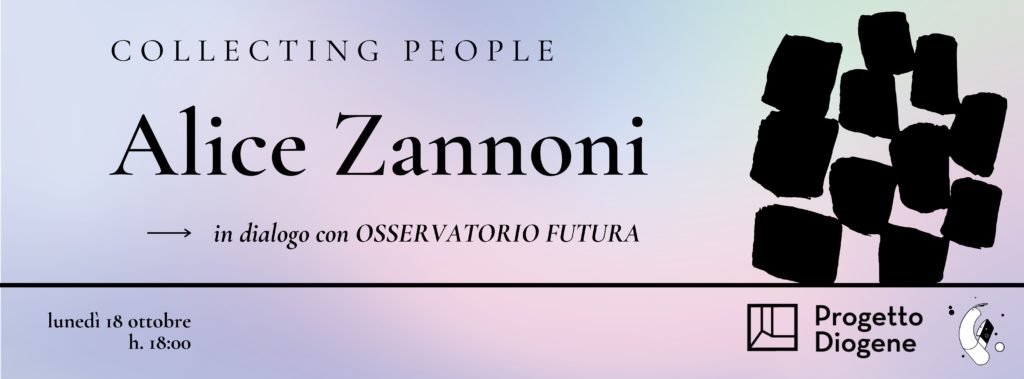
COLLECTING PEOPLE | Alice Zannoni in dialogue with Osservatorio Futura
>>>Monday, October 18, 6 pm
Tram Diogene, Rotonda C.so Regio Parco e C.so Verona, Torino
As part of Collecting People – an initiative aimed at sharing knowledge through extemporaneous meetings and interventions, sometimes determined by the simple passage in the city of a researcher – Diogene Project is happy to host Alice Zannoni in dialogue with Osservatorio Futura.
Alice Zannoni, curator of Bologna and co-founder of SetUp Contemporary Art Fair, carries on a research work on communication and dissemination of contemporary art trying to make it understandable to any unprepared but curious observer. In 2018 she wrote the book “Art contemporary explained to my grandmother “, in which she recounts the experience of dialogue and confrontation with the elderly grandmother Zita on some key themes of artistic research: “I want the pages of this book be a ‘tool’ to train thought to explore (…) a world, that of art contemporary, which can often appear bizarre and meaningless, but which feeds on reality for to exist”.
The will to undermine the elite dynamics of the art public and the demonstration that art can entering into the things of life can generate questions about the intentions of those involved in art: can it affect everyone’s life? if not all, it is possible that it falls within the whole vital sphere, in the passionate dynamics of everyday life? must the artist’s work necessarily ‘reach’ everyone? the profession of the contemporary artist, how can it be modeled on these issues and how it affects the society?
We will try to give answers (or find other questions) with Osservatorio Futura, collective curatorial born in 2020 in Turin, whose project is constituted as an observatory attentive to contemporary artistic projects and the dynamics that govern cultural work in its entirety.
Alice Zannoni
Born in Arzignano (Vicenza) on March 30, 1981. She lives and works in Bologna. She graduated in Aesthetics at Dams-Arte in Bologna with Luciano Nanni, where she also obtained the master in “Culture of innovation, markets and business creation”.
She has been involved in visual arts for over fifteen years as an art critic, independent curator and you collaborate as a freelance with magazines in the sector. She was a professor of History of Design at the Laba di Rimini, Administrative Director of the Campori Foundation; she conceived, founded and directed SetUp Contemporary Art Fair of which you are now Sole Director. You have published the book “L’arte contemporary explained to my grandmother ”(Nfc Edizioni).
Osservatorio Futura
Osservatorio Futura is a fluid research center and exhibition space. An ongoing project evolution composed to date of a digital platform, a non-profit cultural association and one exhibition space in via Carena 20 in Turin. Each part of the project is independent and interconnected.
The mission is the promotion and enhancement of emerging artistic research, with the vision of create a network among young professionals, proposing a good work ethic through the establishment of a virtuous mechanism.
GRIET DOBBELS
TALK
Thursday September 14th, at 6:30 pm
Tram Diogene, Rotonda C.so Regio Parco e C.so Verona, Torino
On Thursday September 14th, at 6:30 pm, at Diogene Tram will be a new meeting of the Collecting People series, aimed at sharing and disseminating knowledge and ideas through which Diogene Project opens up to meetings and extemporary interventions, sometimes seizing the opportunity of dropping in town of an artist or any other high profile cultural figure ready to share their own work.
On this occasion the guest will be the Belgian artist Griet Dobbels (Roeselare, Belgium, 1964) who will present the project Montedellarte, happening organized in collaboration with CIttadellarte – Pistoletto Foundation, Biella and C.A.I. (Club Alpino Italiano).
The happening, open to everyone, will take place in the Italian Alps near Biella on October 1st 2017.
Participants of the happening will walk this line and on the same time participants from around the world will follow the hike via their smartphones or computers. In this way a large group of people will be part of one large artwork.
Montedellarte is a non-profit event that wants to connect different groups of people.
Montedellarte questions the correlation between perception and reality and is about the fact that people sometimes confuse the representation of reality with reality itself.
www.montedellarte.com
https://grietdobbels.be
Information material about the project .pdf
FRANCESCO PEDRAGLIO
ApparecchiareSparecchiare (una battaglia)
PERFORMANCE
25 July, 2017 at 7.30 pm
Trattoria Primavera Via Perugia 19 Turin
On Tuesday July 25, at 7:30 pm, at the Tram Diogene will be a new meeting of the Collecting People series, aimed at sharing and disseminating knowledge and through which Diogene Project opens up to meetings and extemporary interventions, sometimes seizing the opportunity of dropping in town of an artist or any other high profile cultural figure ready to share their own work.
At the conclusion of his residency at P/////AKT (Amsterdam) as a part of the DrawnOnward exchange program, Francesco Pedraglio presents ApparecchiareSparecchiare (una battaglia) — Setting-And-Clearing-The-Table (a battle) — an event that combines texts and ideas he has been exploring during the past months, readapting them to the peculiar environment of a dinner in a trattoria.
COLLECTING PEOPLE / THE ART OF THINKING
Worlds and languages
Collecting People-The Art of Thinking, promoted by Progetto Diogene and curated by Clara Madaro, is a series of meetings in which relationships are intertwined while discussing some pressing issues concerning artistic and philosophical research. The last edition of the project dealt with the methods of direct relationship with the world, interweaving the artists’ and philosophers’ research on emotion, affordance, illusion, and ecology.
The next edition is entitled Worlds and Languages, and it will continue to link art and theory on a journey into the worlds of the arts and languages, starting with three forms of media that are very present in our daily life: video, music, and the Internet.
“The limits of my language are the limits of my world,” wrote Wittgenstein in his Tractatus. Moving within in the social landscape and arts research, one is thus tempted to wonder whether it is the languages that shape the worlds or the worlds that define the limits of the languages. How are the languages of music, science, and cinema semantically and syntactically translated in the visual art world? How do the visual arts transform their languages to mingle with the social circuits of other arts and disciplines? The answer to these general questions is secondary.
The method of The Art of Thinking privileges an analysis of the singularity of each artistic research in relation to the singularity of a theoretical research by exploring the osmotic mechanism leading to the contamination of the media, and questioning whether, by analyzing, forcing, and hybridizing the rules of a language, the possible aspects of reality can be grasped, thereby triggering a short circuit of the artistic and social cognitive categories. The ability to bring together different languages, pushing them out of their disciplinary context, starting with a necessity or a deficit arising from the relationship with reality, makes the visual arts a potentially attractive setting for the generation and regeneration of knowledge, but in any case, the visual art world has its own rules, conventions, and aesthetic and social norms that restrict the game moves.
When they inhabit the blurred borderline between multiple social worlds and languages, do artists and philosophers have a position within the ecology of meanings of theoretical and artistic worlds that allows them to be directors of visions of possible worlds? Collecting People-The Art of Thinking 2016 is situated on the border with artists and philosophers who live in manifold worlds and speak many languages.
TALKS
n°3
Life time. Neoliberalism, bio-politics, acceleration, pace
DANILO CORREALE (artist, New York, U.S.A) and GIOVANNI LEGHISSA (Assistant Professor, University of Turin in Turin, Italy).
July18, 2016 at 6:30 pm
at the Diogene Tram
Since one’s economy acquires a priority in the definition of the organization and perception of a lifetime, the same holds true in the archeology of the knowledge system. The economic paradigms implicated by neoliberalism therefore play a major role in the hierarchy of disciplines. Within this framework which seems perfectly binding, is it possible to identify a space and a time for resistance or for interrogation on the meaning of human existence?
With neoliberalism, production comes to coincide with life. The devices that we handle every day produce data that has effects on the market and puts us directly or indirectly in connection with its algorithms. Production is bio-political, because it happens continuously, and not in circumscribed time and spaces, as in the Fordist work model. The distinctions between work, play, and leisure are increasingly difficult to establish. Productivity and power also pervasively incorporated aspects of life that are considered unproductive, by changing its rhythms.
During the third meeting in 2016 of Collecting People-The Art of Thinking, the artist Danilo Correale and the philosopher Giovanni Leghissa will discuss these issues, starting with their research. How can art and philosophy see the contradictions, gaps, and paradoxes of the bio-political and economic sphere that absorbs knowledge and life? Can any mode of reorganization of time and knowledge be glimpsed in the general working of emotions, feelings, instincts, pain, human relations, desires, dreams, and everything that is connected to the body? Giovanni Leghissa and Danilo Correale move in precisely this space of meaning and desire by interweaving different worlds of knowledge and sociability.
At the end, a short excerpt of No More Sleep No More, a sensorial visual essay by Danilo Correale will be projected inside the Diogene Tram.
Danilo Correale is an artist and researcher born in 1982 Naples, Italy, and he lives and works in New York. In his work he analyzes aspects of human life, such as labor-leisure, and sleep under the lenses of time and body. His work has been presented in numerous group exhibitions, including Pigs, Artium, Spain (2016), Ennesima, Milan (2015), Kiev Biennial, Kiev (2015), Museion, Bolzano (2015) Per-formare una collezione, Madre Museum Naples (2014), Steirischer herbst, Graz, (2013) Fondazione Sandretto Re Rebaudengo, Turin (2012), Manifesta 8 in Murcia/Cartagena (2010), Moscow Biennial (2010), Istanbul Biennial (2009). Recent solo shows: Tales of Exhaustion. La Loge, Brussels BE (2016) The Missing hour. Rhythms and Algorithms, Raucci/Santamaria, Naples (2015), The Warp and the Weft, Peep-Hole, Milan (2012), Pareto Optimality, Supportico Lopez, Berlin (2011) and Entrèe, Bergen (2011), Tales of Exhaustion, Cur. By Matteo Lucchetti, La Loge, Brussels, BE (2016). Correale is the founder of the Decelerationist Reader and a regular contributor to publications in the field of critical theory. He recently published The Game – A three sided football match, FeC, Fabriano (2014) and No More Sleep No More, Archive Books, Berlin, 2015.
Giovanni Leghissa (Trieste, 1964) is an Assistant Professor in the Department of Philosophy and Educational Sciences of the University of Turin. He has taught philosophy at the Universities of Vienna, Trieste, and at the Hochschule für Gestaltung in Karlsruhe. The editor of “aut aut” (either or) since 1988, he edited the Italian edition of the works of Derrida, Blumenberg, Husserl, Overbeck, Tempels, and Hall. His publications include: The mortal god; Assumptions about modern religion (Medusa, Milan 2004); The identity game; Difference, otherness, representation (Mimesis, Milan 2005); Incorporating the old: Classical philology and invention of modernity (Mimesis, Milan 2007); and Neoliberalism. A critical introduction (Mimesis, Milan, 2012). His areas of research address the critical epistemology of human sciences, phenomenology, psychoanalysis, the relationship between religion and modernity, intercultural philosophy, and Postcolonial and Cultural Studies. For several years, his research has aimed to investigate the changes in the relationship between economic rationality and political rationality in the neoliberal age.
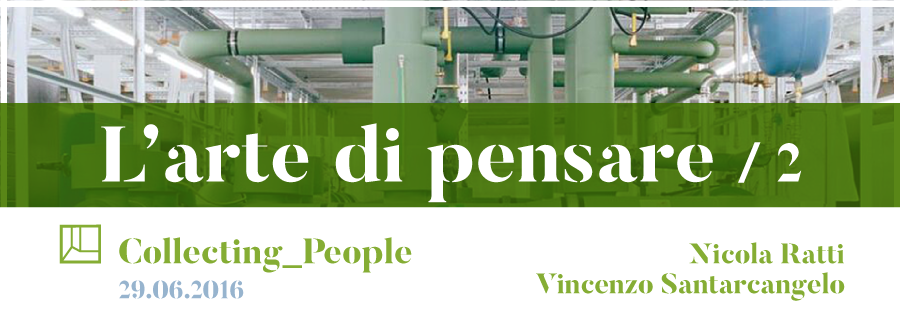
n°2
Sound Worlds
NICOLA RATTI (Artist, Milan) and VINCENZO SANTARCANGELO (Ph.d in Philosophy, University of Turin).
Turin – June 29, 2016 at 6:30 pm,
at the Diogene Tram
Sound has strong emotional, cognitive, communicative, interactive, and social significance, such that is very difficult for us to imagine our life as a silent film. Not only is music one of the art forms with which we prefer to surround ourselves, but sounds and noises accompany us constantly, offering us multiple possibilities of contact with the world.
A actual sound environment emerges from artifacts, animals, matter, and the relationships between them. We manage to interact with a part of the sound objects that constitute this ecology in a way that is more or less comparable to how we grasp any type of object or scrutinize certain visible traces to orient ourselves in space. Nevertheless, it is not exactly obvious just what kind of objects sounds or noises are, and what it means to grasp them, understand them, and move around within the sound environments they produce.
Sound Worlds, the second meeting of Collecting People -The Art of Thinking 2016, will be an opportunity to explore these nodes, beginning with the research conducted by Nicola Ratti and Vincenzo Santarcangelo: artistic, musical, and philosophical research comparing sound through the discussion of an ecological approach to auditory perception. What kinds of things can we do with sounds? What skills and knowledge do we need to develop to be able to grasp their potential of interaction?
Nicola Ratti’s research stems from musical composition, highlighting its potential to create sound environments that interact with video or plastic worlds, thereby opening up possible scenarios.
Vincenzo Santarcangelo explores the nature of sound in the philosophical and experimental theories of perception in relation to everyday life, the world of music, and the visual arts. By talking about this research which touches on many artistic and social spheres of knowledge, we will develop a mode to investigate our relationship with sound more deeply through the interweaving of a relationship between music and theory. It will be possible to view a work by Nicola Ratti inside the Diogene Tram at the end of the meeting.
Nicola Ratti is a multi-talented musician and sound designer who has been working for years in various experimental fields. His live performances have been held in Europe, North America, and Russia, and he has recorded albums with Anticipate, Preservation, Die Schachtel, Entr’acte, Where To Now?, Senufo Editions, Boomkat Editions, Holidays Records, Megaplomb, Musica Moderna, Boring Machines, Coriolis Sounds, Zymogen. He has worked with Giuseppe Ielasi, with whom he started a project called Bellows, and with Tilde, a trio with Enrico Malatesta and Attila Faravelli. He played guitar in the group Ronin from 2007 to 2013. He has collaborated with visual artists, including Nicola Marini, Alessandro Roma, Riccardo Arena, Ferruccio Ascari, Blisterzine/NastyNasty, and Sara Enrico. From September to December 2014, he curated The Variable Series, a series of events regarding sound and performance hosted by O’ in Milan, and since May 2015, he has also curated a series of events relating to sound at Standards, an experimental gallery of sound research in Milan. He has been one of the promoters of an electronic music festival, Auna, conceived as a moment of exchange and research among Italian artists, since its first edition in 2012.
Vincenzo Santarcangelo has a PhD in philosophy and is member of the LabOnt research team at the University of Turin. He was a visiting PhD student at the Institute of Cognition at Plymouth University. He translated The Ecological Approach to Visual Perception by J.J. Gibson (Mimesis 2014) and was the editor of Have Your Trip: The music of Fausto Romitelli (Auditorium 2014). He has taught courses in Aesthetics at the University of Genoa, the Rivoli Museum of Contemporary Art (Rivoli Castle) and MADRE, DonnaRegina Museum of Contemporary Art (Naples). He has collaborated with the newspaper Corriere della Sera (Reading) and Rai Culture, and edits the columns “Octave Chronics” and “Dialogues of Aesthetics” in Artribune. He is the artistic director of the music festival From Sign to Sound (Dal Segno al Suono) at MUSMA, Museum of Contemporary Sculpture (Matera), and a consultant for “Florence Contemporary Sounds” (Firenze Suona Contemporanea) and “EastWest Festival” (EstOvest Festival).
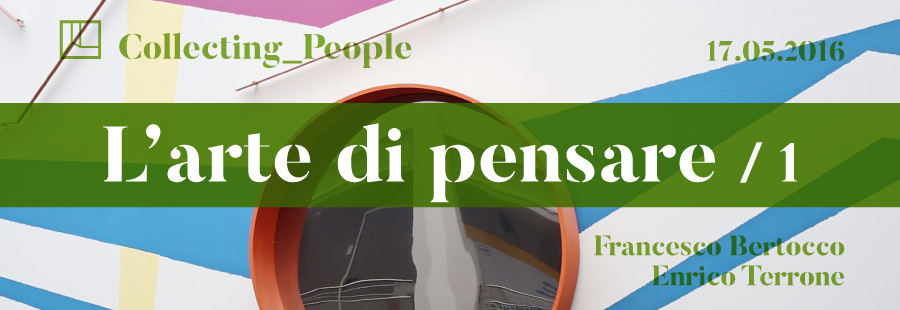
n°1
Setting Worlds.
FRANCESCO BERTOCCO (artist)
ENRICO TERRONE (Post-Doctoral researcher, Collège d’ètudes Mondiales, LabOnt, Laboratory for Ontology, University of Turin).
The worlds of science, psychology, cinema, and the visual arts are the stage or settings that make research, narrative, therapy, and imagining possible. Scientific laboratories, manufacturing plants, studios, and therapy centers are places where various types of facts are routinely recorded or produced daily in a complex relationship between reality and fiction.
Philosophy and the visual arts observe these phenomena, and wonder about their problems and multiform essence or the conditions that would allow the effective implementation of these practices and knowledge within a given paradigm by analyzing them from conceptual, narrative, and visual points of view or through performativity. The artistic and philosophical points of view can shift the focus of investigation, thus redefining the relationship between social, visual, and theoretical norms and facts by paying attention to the mechanisms that give rise to contingent situations deemed necessary.
The topic of the first meeting in 2016 of Collecting People-The Art of Thinking is Setting Worlds: how video art can bring all these languages, worlds, and contradictions together to create a reality that is greater than the sum of its parts, and how philosophy can accompany this process.
The artist Francesco Bertocco stages the settings that determine the therapeutic, productive, and scientific practices through a video that creates a body analysis and performative space. Enrico Terrone, a researcher in philosophy, deals with all the theoretical devices that allow us to analyze a video image in its multiple relationships with reality and with our own background knowledge or social conventions. How do these philosophical concepts hold up with regard to the relationships prompted by this video, in which several worlds intersect? How does the view incorporated in this work open up new possibilities for understanding, sociality, and theories, thereby forcing the definitional boundaries of languages and current worlds?
Francesco Bertocco and Enrico Terrone will explore this area by talking about their respective artistic and philosophical research, and the interwoven relationship between art, philosophy, cinema, and research environments in general. One of the artist’s videos will be projected inside the tram after the meeting.
Bios
Francesco Bertocco (Milan, 1983. Lives and works in Milan). Bertocco is an artist and filmmaker, whose research focuses on the linguistic complexity of the documentary genre. Recently, he has been researching the relationships between documenting and scientific imagining. After receiving his BA degree in Modern Literature, in 2011, he earned a degree in Film and Video from the Brera Academy of Fine Arts. He has presented his research in solo and two-person shows: Through a glass darkly, BACO, Bergamo, Italy; Allegoria (with Aberto Grifi), Viafarini DOCVA; Eclissi, MAGA Art Museum in Gallarate; F (with Alessandra Messali), MAC, Lissone, in collaboration with Viafarini DOCVA; Role Play, Lucie Fontaine, Milan; Focus Group, ROOM Gallery, Milan. His work has been shown in group exhibitions and festivals: OCAT, Shanghai; Kino der Kunst, Münich; Museum 900, Milan; Glitch. Interference between art and cinema in Italy, PAC-Pavilion of Contemporary Art in Milan; Vision du Réel – International Documentary Festival, Nyon, Switzerland; The Art Screen, Florence; Errors Allowed – Mediterranea 16, Ancona. He has recently had exhibits at Careof DOCVA (ArteVisione, a project in collaboration with Sky for the social support of young Italian artists.), Milan; Luigi Pecci Center for Contemporary Art in Prato; Merz Foundation, Turin; and the International Filmmaker Festival, Milan.
Enrico Terrone has a degree in engineering, a PhD in philosophy, and he is a qualified university teacher of cinema, a subject that he has taught at the University of Eastern Piedmont. He is a member of Labonte (Laboratory of Ontology, University of Turin) and editor of the magazine Segnocinema. He is the author, together with Luca Bandirali, of the books: “Nell’occhio, nel cielo. Teoria e storia del cinema di fantascienza” (“In the eye, in the sky. Theory and history of science fiction movies”, Lindau 2008), “Il sistema sceneggiatura. Scrivere e descrivere i film” (“The script system. Writing and describing movies”, Lindau 2009), “Filosofia delle serie tv. Dalla scena del crimine al trono di spade” (“Philosophy of TV series. From Crime Scene Investigation to the Game of Thrones” (Mimesis 2012). His latest book is “Filosofia del film” (“Philosophy of movies”, Carocci 2014). In 2014, he was named research fellow at the Käte Hamburger Centre for Advanced Study in the Humanities in Bonn, and since 2015, he has been a research fellow at Collège d’études Mondiales in Paris.
2015 THE ART OF THINKING
COLLECTING PEOPLE / THE ART OF THINKING
curated by Clara Madaro
The Diogene Tram will be the site of the inauguration on April 23, 2015 at 5:30 p.m. of Collecting People 2015 – The Art of Thinking, a series of encounters combining artistic and philosophical research on urgent topics for both disciplines. If the philosopher is a friend of knowledge, we cannot understand what philosophy is until we understand what it means to “be friends”. Each appointment is aimed at interweaving a relationship of friendship between art and philosophy around the theoretical and applied interests shared by the two guests, highlighting the specificity of their contributions and languages. The crux of their own research is presented by a philosopher and an artist or a curator; then a conversation between the two will follow. Thinking together, comparing languages, gathering theoretical ideas and mutual applications, clarifying and complicating their ideas in a direct confrontation with another reality: these are the processes that are meant to be triggered. The encounters gradually deal with some of the difficulties of contemporary research that, in addition to involving a comparison of neuroscience, biology, economics, and social sciences, have a pervasive importance in everyday life where their concrete aspects emerge in the reasoning, talking, relationships, in the representative gaps, and the uncertainties. The art of thinking is a double opportunity: on the one hand, it allows the general public to become familiar with the research methods of artists, curators, and philosophers, and on the other hand, researchers will be able to answer questions on the nature, the narrative, and the definition of their work. The encounters will take place at the Diogene Tram on the roundabout at Corso Regio Parco/Corso Verona, in Turin.
EVENTS
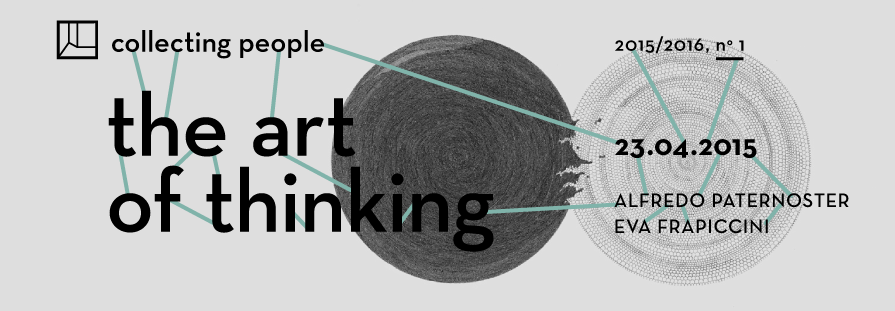
n°1 Feeling you exist. Perception, emotion and memory.
ALFREDO PATERNOSTER (Professor of Philosophy of the Mind at the University of Bergamo, and Doctorate Program in Humanities of Turin University, and at FINO – Consortium of Doctorate in Philosophy in the North West of Turin) EVA FRAPICCINI (Artist and Adjunct Professor at the Academy of Fine Arts in Bologna and the IED-European Institute of Design).
What relationship does philosophical and artistic research have with the knowledge coming from neuroscience and cognitive sciences in regard to the issue of construction of personal and collective identity?
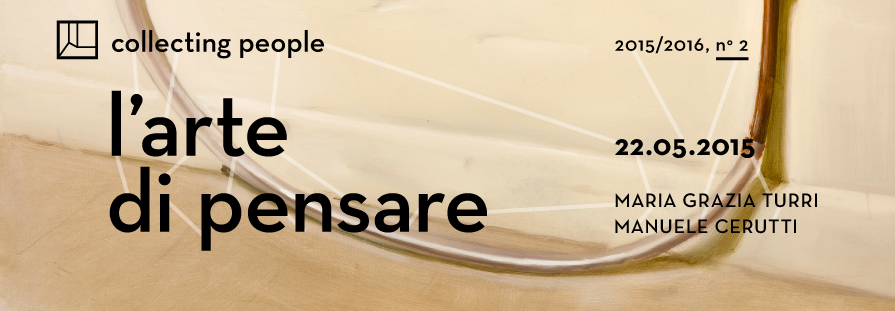
n°2 Relating with everyday objects. Form, function, and social relationships. What is an everyday object? How do we relate philosophically and artistically to an everyday object when it comes to representing or defining it?
MARIA GRAZIA TURRI (Adjunct professor of corporate communication languages, University of Turin) MANUELE CERUTTI(Artist).
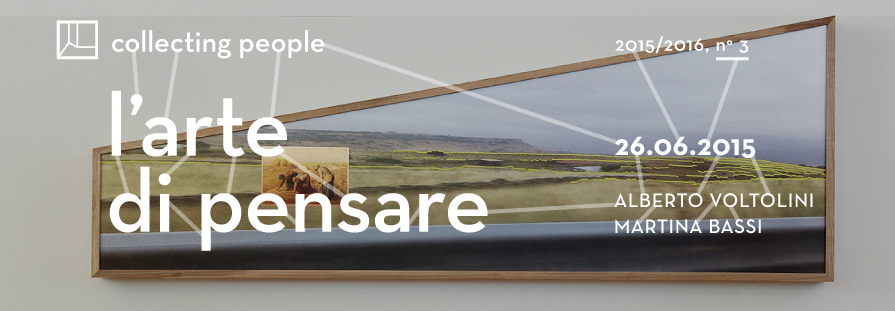
n°3 Illusion. The difference between perception and knowledge. Why is it that we can’t stop deluding ourselves perceptually? The artistic and philosophical research reflecting on perception.
ALBERTO VOLTOLINI (Professor of Philosophy of the Mind at the University of Bergamo, and Doctorate Program in Humanities of Turin University, and FINO – Doctorate in Philosophy Consortium of the North West) MARTINA BASSI (Artist and Professor of Philosophy).
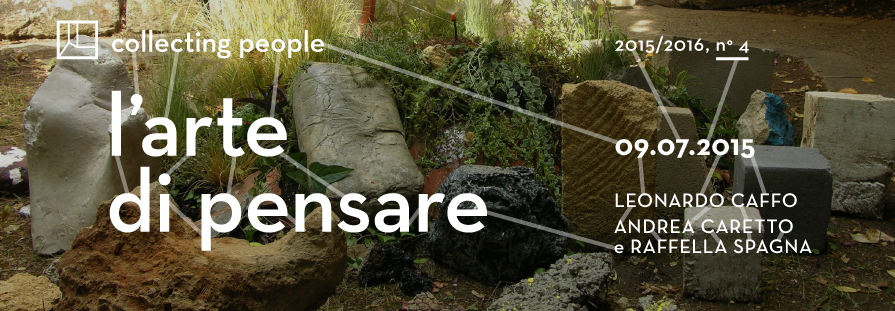
n°4 Moving away from the center. Thinking without anthropocentrism. How can artistic and philosophical research identify ways of thinking and practicing an ecological discourse?
LEONARDO CAFFO (Ph.d in Philosophy, University of Turin) ANDREA CARETTO E RAFFAELLA SPAGNA (artists).
2012 APNEA
APNEA 2012
Mayol said to me: “If you want to dive with me, give up your human personality, take off your diver watch. You should not have any other goal but this: every time you dive you must go deep into your feelings and, in order to do that, you cannot be concerned with the meters of depth or the seconds in apnea.”
Umberto Pelizzari
Poetry Slam has been called “art of sport and sport of art”. It started in the USA, where Mark Kelly Smith is credited with starting the project in the second half of the 80s, and it aims to approach public to poetry again. More recently, in 2001, the dutch artist Iepe Rubingh transported from a comic strip into reality a nonexistent sport, Chessboxing, carrying on his aim to approach public to contemporary art again. An artist from Giorgia Vian chooses the pole-jumping as art research field, and the runner Marco Olmo, one of the greatest exponents of ultra marathons, exalts sport’s spiritual side.
The meetings intend to start a reserch on the less known sport’s side to general public, the psychological training, and to show how close are the approach to sports disciplines and the one to art. If technical aspects are different from sport to sport, somehow psychological training is the red shed connecting all of them: analysis of sensations, motivation, concentration, visualization, identification with the surroundings, performance. It is matter of going beyond one’s body, beyond the realm of chronometers and heart rate monitors. It is the forgotten realm of every human action, even the sports’ one.
Fabio Calzia
SAGARA POETICA
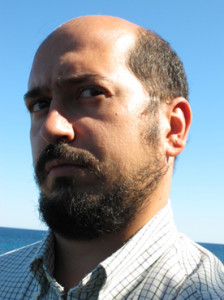
Sa gara poetica is a traditional performance from Saridnia. It has nothing to do with a dross of the past. Poets do live in the present time, and they want the Sardinian language to be the language of their music and of the people who follow and support them.
Monica Barbero (diver)
LOOKING AT THE BLUE WITH EYES CLOSED
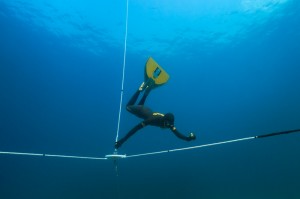 In this meeting, “Apnea” is much more than a title. The guest is Monica Barbero from Turin, Jump Blue and dynamic apnea champion. We’ll dive with her into her sport’s knowledge, to discover how she approached this discipline of deep concentration, what difficulties she had to clear to be an excellence, the block she had to get through, and her restart.
In this meeting, “Apnea” is much more than a title. The guest is Monica Barbero from Turin, Jump Blue and dynamic apnea champion. We’ll dive with her into her sport’s knowledge, to discover how she approached this discipline of deep concentration, what difficulties she had to clear to be an excellence, the block she had to get through, and her restart.
Monica will let us share in diving’s psychological implications, what happens in human mind when diving into an element which is completely different from the one we are used to live in, where there are other rules and unique physiological reactions.
What pushes someone to approach apnea? What happens in water’s darkness? What does to be a diver mean, if transposed into everyday life?
Monica Barbero, Turin 1973, MA in Literature, archaeological course of studies. She is a diver and a diving instructor, besides being the Italian National Team FIPSAS’ leading athlete since the end of the ’90s. In 2003, she is both dynamic apnea absolute Italian champion, and Italian champion with 147,46m. In the same year, at Tremiti Islands, sets Jump Blue apnea’s world record with 92,97m. In 2004, she sets the world record, not ratified, and the dynamic apnea’s Italian record during the Italian championship, with 167,42m, breaking the record (160m) she set earlier in the same year, during a selective competition, and she is discipline’s Italian champion.
In 2009, she sets Jump Blue apnea’s new world record, not ratified, during the Italian Championship in Noli, with 143,33m, and she is discipline’s Italian champion. In August, she gets second place during Dynamic apnea World Championship in Aahrus , Denmark, with 181,92m. In october, she is Jump Blue European champion in Tenerife, also setting the world record with 144m and gets fourth place in Dynamic apnea. In 2011, she gets second place in static apnea and dynamic apnea with fins. In Genoa Quinto she is the winner during Jump Blue Italian championship, setting the new World and Italian record with 145,12m. In the same year, during the Tenerife World Championship, she gets Jump Blue’s third place and sets the Italian record with 147,50m.
Gianluca Sirci
CHESSBOXING’S ITALIAN FACE
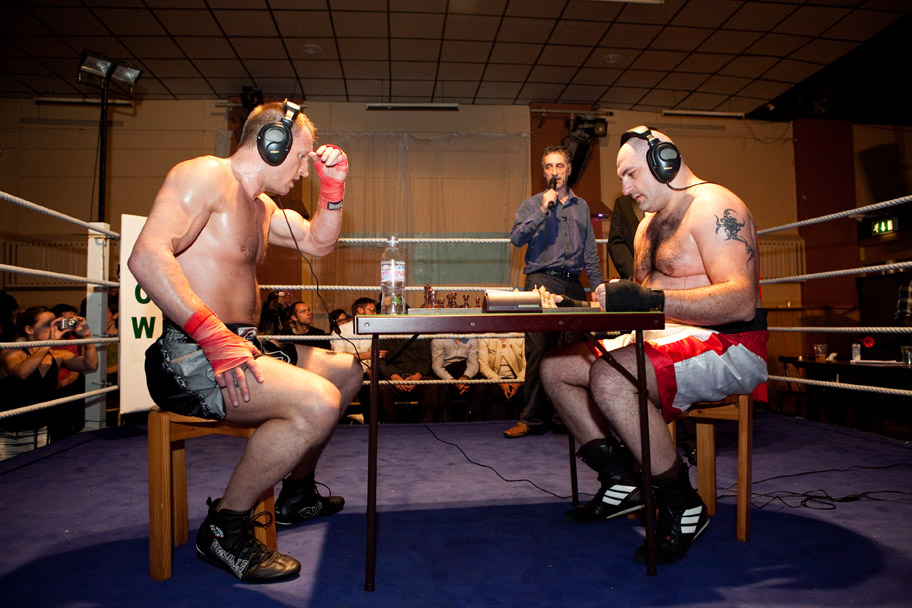
The concept was Enki Bilal’s, who put a chessboxing match in his graphic novel Frid Equateur in 1992. Then, a Dutch artist, Iepe Rubingh, got inspired from Bilal’s book, and brought the concept into reality in spring 2001, playing with the name ‘Iepe the Joker’. Rubingh decided that the way it went on in the book, one match for box and one for chess, didn’t work, so he interchanged more and shorter matches of chess and box. Staying at the London Times, it is the new discipline that is growing faster in the world. Surely, it is new, and excite curiosity. It is exactly what its name says: the midway between chess and boxe. Chessboxing’s Italian face is Gianluca Sirci from Foligno, chessboxing heavyweight European champion since October 2009, when he won the title in London, beating the English player Andrey ‘The Rock’ Costello by mad chess at the end of the ninth round. Collecting People/Apnea calls Sirci to live with him again that match, and to go deeper into this world’s physical and psychological dynamics.
Gianluca ‘The Doctor’ Sirci, so he is called in chessboxing world, is 1,87m tall for 120kg of weight. In his Palmares shows a third place at Kung Fu World Cup in 2001, three titles of University Box Italian Champion, professional since 2005, he also takes stabs at disciplines as Full Contact and K1. Besides fight disciplines, he is also strong in Xiagqi, a chess chinese version.
Marco Olmo
“RUNNING”
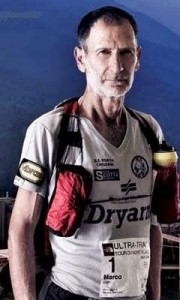
Marco Olmo starts to run in a peculiar way, after an inner push to take revenge of his life. There he finds balance and equity that get lost and confused in everyday life. His determination brought him to the self’s deep knowledge, beyond measures, trainers, and diets. This meeting will be about the race competition’s psychological training, body’s and mind’s feelings during the race, what happens to them from a certain number of miles on. Does the so-called race trance exist? And how is it? And how to reach excellence abandoning all measurings given by technology? As Mayol said to Pelizzari: ”If you want to dive with me take off your diver watch […]. You must go deep into your feelings and, in order to do that, you cannot be concerned with the meters of depth or the seconds in apnea.”, so Marco Olmo seems to say to us, not just about running, but about everyday life.
Despite he’s 60 years old, Marco Olmo is regarded as one of the best expert in extreme running. He became late, when the others started to stop, as he says. At 40, he started to face extreme competitions in the African desert, such as the Marathon des Sables, 230 km in total food self-sufficiency in the Moroccan desert’s treacherous weather conditions, the Desert Cup (168 km in the Jordan desert), the Desert Marathon in Libya, and the Ten Commandments Marathon (156 km up Mount Sinai), collecting success after success. Wandering around the world, he came to the Martinica’s Tible Raid, there he scored fifth place, and to the Californian desert’s Bad Water Ultramarathon: 135 miles non-stop from Death Valley to Mt. Whitney (from -282 ft below sea level, United States’ lowest point, to 8300 ft), where the temperatures go over 126°F (about 52°C).
At the age of 58, he became World Champion winning the Ultra Trail du Mont Blanc, the hardest and most important endurance race in the world, over twenty hours of uninterrupted running, 167 km (over 100 miles) around the tallest mountain in Europe.
www.mountainblog.it/marcoolmo/
Giorgia Vian
WHEN THE BAR DOESN’T FALL The pole-jumping and the artwork’s training
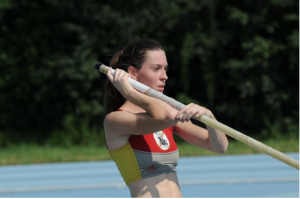
At twenty-four years of age, Giorgia Vian starts to do competitive sports as a pole-jumpinger. Her research of a personal record is parallel with the original artwork’s training. Each sport helps the other one, staying distinct in its own specificities. To start a sport in a ripe age entails a disproportionately high consciousness, which brings both advantages and remarkable difficulties. Pole-jumping requires both irrational qualities and extremely cool-headed ones. It is then necessary to have physical and mental coordinative abilities, and basic simpleness. As time goes by, training brought her to know her body in an extremely refined and practical way, in both athletic effectiveness and organised image of herself. The ability to see herself developed an artistic series of drawings related to sports’ gestural expressiveness. The more sport becomes an interesting and demanding bet, in the full awareness of its orthodoxy, the more the artist is pushed to sack methods opened by art to create environment, physic, and the best psychology to practice excellence.
Giorgia Vian was born in Genoa in 1984. Today, she is living in Milan her greatest passions. In 2010 she took part in Permio Termoli, curator Miriam Mirolla; in 2011, she’s at the Biennale di Venezia, Italian Pavillon, section The State of The Art; at Cose Cosmiche 1 e 2, Artra Gallery, Milano, and at the rartist residency in Ruinas, Sardinia, curator Mauro Cossu. In 2012, she set her personal record in pole-jumping at 3,80 mt. She is experiencing her artwork on secondary school’s gym. She is measuring her progresses on the athletic field.
Eliana Deborah Langiu THE POETRY SALM: POETRY AS A SPORTS DISCIPLINE
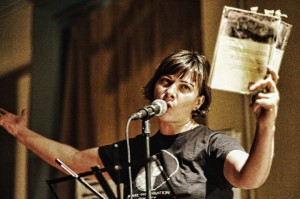
Eliana D. Langiu is a Turinese writer. She is chiefly involved in poetry, and periodically takes part to Poetry Slams, competitive matches among poets based on reading original texts. This is the research field she chose to show Poetry Slam’s range as an art project, started by Mark Kelly Smith, and as a contact among writing, voice, and body in a dimension that takes possession of sports dynamics: starting from the training of voice and body to concentration during the performance and to the psychophysical reactions to the obtained result. Through her research she studied some individual sports in which the athlete/poet is alone with the public at the moment of the action.
For this first meeting, Collecting People/Apnea, Eliana D. Langiu will then introduce, so to speak, an expanded world, in the middle of which there is the resarch on psychological aspects of intersecting disciplines, where voice and body trainings are put on the same level. During the meeting, information will be given regarding the athletes guests who will take part to the next meetings.
Eliana Deborah Langiu was born in Turin in 1973. Her first poetry collection, Rag Time, was published in 1993, followed by publications of tales on literary magazines and anthologies. In 2007, her poems are in the antology Le carte tatuate. Dieci poeti torinesi edited by Tiziano Fratus for the Torino Poesia press. In 2008, the same press published her collection Polaroid, and in 2010 Polaroid (secondo volume). In the meanwhile (and afterwards) her poems were translated and published in english and french magazines and collections. For the same publisher, she translates poetry collections from English into Italian. In 2011, she made the special edition Trentotto, composed of thirty-eight self-published monotype booklets.
2011
Lorenza Boisi
Flâneur/Antipodista -CONVERSAZIONE CRITICA INCIDENTALE
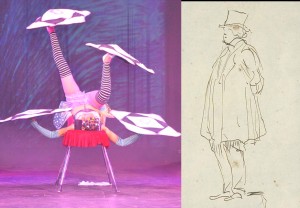
Infinite are the so called impossible conversations, some are improbable… and this incipit shall sound like a disclaimer…
I’ll try to activate an improbable conversation conjugating the contracted posture of an antipodist (foot-juggler) and a flâneur ‘s relaxed diverting pace… in absence of any historical and critical contextual setting and without the help of a “medium”, borrowing pretexts, praxis and pràgma and all conjuring with my empirical knowledge…
Thus Antipodist vs. Flâneur. As the first runs stubbornly feet up against the sky in a corrupted and virtuosoes effort, the latter “walks tortoises at the leash” in an conscious effortless stroll with no precise urgencies.
I’m hoping to open a conversation upon those subjects that I have been told some might want me to be relating…
Lorenza Boisi lives and works in Milan since 2005. She has been working and still collaborates with several interesting Italian and foreign galleries and has taken part in various international group shows. In 2008 Lorenza Boisi founded MARS- Milan Artist Run Space and headed the initiative for the 2 following years, in 2010 she founded CARS- Cusio Artist Run Space in Omegna (VB) that she is presently directing. Selection of solo shows: 2011 Water and ME. Galleria Federico Luger, Milano, IT. 2010 CONTUSIO INQUISITIONE OBSCURA, Palazzo Esposizioni, Faenza. IT-collaboration with MCZ – Museo Carlo Zauli. NIGHT VISION, Metroquadro, Rivoli, IT 2007 LORENZA BOISI, Diana Stigter, Amsterdam, NL 2006 CALL ME WINTER, CALL ME SNOW, Manuela Klerkx, Milano, IT, 2005 STORY TELLERS, Federico Luger Gallery, Milano, IT 2004 SONGE, Laurier, Parigi, Curatore Florence de Voldère, Jane Harper
2010
Fucking Good Art
22 March 2011Fucking Good Art is an artists duo formed by Rob Hamelijnck and Nienke Terpsma. Since the publication of the first Rotterdam issue in December 2003 they have made issues in Munich, Berlin, Dresden, Copenhagen, Riga and Switzerland and more. This will be the first Italian commission, framed in a very specific time in the political history of the country and follows closely the Swiss Issue, realised by FGA in 2008.
28 Novembr 2010Angela Serino (1977, curator)
For the series of meetings Colletting People, Angela Serino, curator in residence at Nosadella.due, presents The artist, the prostitute and the creative, a story of words and images with three figures who exchange, seek and repel each other in the red light district of Amsterdam. Collecting People was designed as an opportunity to share in the space of the tram, a collection of reflections, thoughts and insights of artists, critics and theorists of the contemporary cultural scene. This series of informal meetings is designed as an instrument of knowledge and analysis, developed through a spontaneous exchange of experiences. The selection of invited guests follows the criteria laid down by the curiosity to explore some aspects, more or less clearly, to contemporary art, with the intention to create a cultural debate and give rise to fruitful interdisciplinary collaborations. A special thanks goes to the a.titolo nonprofit organization, founded in Turin in 1997 with the aim of promoting contemporary art oriented toward the social, political and cultural public space.
22 October 2010Carissan Carman (U.S.A. artist) Logan Smith (U.S.A.visionary builder and inventor)
Carissa Carman’s interdisciplinary artwork incorporates social practice directed by the construction, design and usability of specialty objects and services. These playful interventions in site-specific environments are pseudo –purposeful yet soulful and generous. Her performances, sculptures and printed materials reference already established systems, occupations, and skills while maintaining the aesthetic of the handmade. Her collaborative practice partners with artists and professionals to negotiate the exchange of trade skills as a pioneer of do-it-yourself mastery. With reference to institutional formats and settings, Carman uses bogus instructions and surprising structural and innovative riffs on expectations of each object’s function.
Carissa Carman received her B.A. of Fine Arts from California State University, Chico (2001). She based her career in NYC from 2003-2009. She most recently was the Director of the Living Systems for internationally publicized Waterpod Project, and Residency Coordinator of Chashama North, NY. She has exhibited widely in NYC: Exit Art, Figment, The Muster, Creative Time, Islip Museum, Scope Art Fair NYC, Verge Art Fair Miami, the Women’s Studio Workshop and internationally at FOFA (Concordia University), Occurence (Montreal) and Romerias in Holguin, Cuba. She is the recipient of the Mechtronix Fellowship and residencies and funding from New York State Council of the Arts, Andy Warhol Foundation, New York Foundation of the Arts, Lower Manhattan Cultural Council: Swing Space and Sustainable Concordia (Quebec). Carissa is co-founder of Dusty Hollows, a collaborator in SP Potluck (NYC), the Wild Feasties (NYC), [insert title here] (QC) and The Color Collective (QC). She has works in private collections at Yale, RIT, RISD, Virgina Commonwealth and Wesleyan University. Carman currently resides in Montreal, QC is a research assistant for Subtela Labs, Hexagram and is a Master of Fine Arts Candidate in Fibres. www.carissacarman.com
Logan Smith is a visionary builder and inventor, a natural horticulturist, a survivalist and a native of Northern California from a diverse background. He is a principal builder, and directed/participated in much of the fabrication of Waterpod™. As a primary advocate and member of the Living Systems team, he contributes his passionate gentle group management, leather working, attentiveness to work music, handiwork skills, and experience working with soils and run-off from years of maintaining primitive trails in the western mountains of Wyoming and Colorado. He additionally has extensive skills in primitive survival techniques from his time as a Therapeutic Wilderness Therapist in the West Deserts of Utah. Logan designed and fabricated with Carissa Carman, Waterpod™’s treddle watering system that pumps water to the gardens
martedì 29 June 2010Alessandro Quaranta (Torino 1975, artista) www.alessandroquaranta.it
BIRD WATCHING / BEING WATCHED o nell’attesa
18 June2010Radical Intention (Michele D’Aurizio, Maria Pecchioli, Aria Spinelli) AZONE D’AUTONOMIA / ZONE DI COOPERAZIONE
4 June 2010Alessandro Nassiri (Milan 1975 artist) Aria Spinelli (New York 1981, curator)
WAITING FOR THE TRAM “Pedro Pedreiro is pensive and waiting for the tram, perhaps tomorrow he will have to wait again And, for whom? For whom? penniless Pedro Pedreiro Is thoughtful and and he keeps thinking, time passes and we stay back Waiting waiting waiting ….” Every day the city is in a constant high speed movemnet, While people waiting for the tram often find a quiet moment for reflection. Pedro Pedreiro is a Brazilian song written by Fransisco, known as “Chico” Buarque de Holland. In 1967 Enzo Jannacci included the Italian version on his famous album “Vengo anch’io, no tu no” The song tells the story of the poor Pedro who dreams of a better world while waiting for the tram. Pedro is a Pedriero a music form of Beckett’s existentialism sung to the hot rhythms of South America. Alessandro Nassiri Tabibzadeh ‘s works always commence with a innocent and simple existential questions: Where do cars go when we buy new ones? Can I chase a cloud? How many calories do I burn in a full day of unpaid work? The artist examines complex issues of social emergency with devastating irony. He triggers critical reflection asking questions that simply elicit a laugh. To understand Nassiri’s work its therefore necessary to start from a question, in this case, asked to those who are waiting at the tram stop: what are you waiting for? The existentialism of Milan told through a vague answer or a quick comment, of those who are waiting for “nothing else than the endless afflicted exhausted hope, that they’re ride is coming..”
28 May 2010Antonio Limonciello (presidente associazione Zerotremilacento)
MUM, THE TURKS! ISTANBUL BIENNIAL 2009 “In Istanbul you feel like one of those Americans in Rome in the 60s who came and marvelled at the shamelessness if the city in those years. There I was, eyes bulging at the sight of the powerful, explicit social and political comment of the work on show at the Biennial – the most important event. Then I soaked up the vitality and enthusiasm of the young Turkish artists whose ingenu usness and nerve is representing the nation by probing their roots while coming to terms with a future that is bordering on collapse. Bordering on this – but not too close – is the Biennale’s geopolitical role, nestled where it is between the ex-Soviet Empire and the former Ottoman Empire. Here is a humus of hope and disappointment, negation and recovery, nostalgia and projection into the future (all tackled by – let me make it clear – a non expert).”
14 May 2010Groshgrup (Laboratorio creativo italo-albanese-argentino)
TiRaNa – ToRiNo identità spezzate
“The idea of the bivouac is part of Groshgrup’s DNA. It all started after visiting Diogene’s bivacourbano in 2008.We asked ourselves, ‘How can we tell the story of those people who are pushed to the fringes of society and forced to live in bivouacs?’ Groshgrup is made up of people on the move – immigrants and migrants. Our first action, La notte fuori (a night out), involved sleeping out in the Stura Park in order to re-live our clandestine experiences before retelling the stories using new languages.Diogene’s tram-bivouac fits into this narration by creating a powerful short circuit. In the past the tram was a means of public transport where you could find shelter and warmth while leading a modern urban nomadic clandestine existence; now that it is sitting on dead track, it has become a new form of welcome stopping-off point where we can work out our experiences and our ideas.”
4 May 2010Jacopo Iacoboni (Naples, 1972, journalist and writer)
THE POWER OF BODIES AND POLITICAL SICKNESS A trip into post-political narration of Noughties Italy through images, reflection and personal accounts – Berlusconi, the revolution of the ‘King’s body’ and cultural desacralization imposed – possibly – by the Internet.
Jacopo Iacoboni is a journalist for La Stampa who writes on politics and society. In recent years he has covered top political events as a correspondent. He has also written three books: Heidegger e la questione della contingenza (Heidegger and the question of contingency), Il Mulino 1998; Votantonio, viaggio nell’Italia elettorale (Votantonio: election time in Italy), Donzelli 2000; and Profondo rosso. La sinistra perduta (Deep Red: the lost Left), Einaudi 2009.
venerdì 23 Aprile 2010Sergio Caretto (Turin, 1966, psychotherapist, psychoanalyst, member of the Lacanian School of Psycoanalysis)
REPRESENTATION AND THE BODY IN THE ROUNDABOUT SOCIETY Where do representations of the body and the body itself fit in a society like ours, which has pulled the plug on traffic lights and all their limits in favour of the roundabout? Perhaps a tram or a streetcar named desire can bring art and psychoanalysis in a roundabout way round the same table.
13 Aprile 2010Luca Bertolo (artist)
ALTERITA’ E OGGETTI VAGHI Fare arte vuol dire creare elementi di diversità? E diversità rispetto a cosa? Quanto si mimetizza il nuovo? E’ tutto oro quel che luccica?
7 Aprile 2010Driant Zeneli (artist)
LA CONSAPEVOLEZZA DEL CASO

